Weitong Zhang
Near-Optimal Second-Order Guarantees for Model-Based Adversarial Imitation Learning
Oct 10, 2025Abstract:We study online adversarial imitation learning (AIL), where an agent learns from offline expert demonstrations and interacts with the environment online without access to rewards. Despite strong empirical results, the benefits of online interaction and the impact of stochasticity remain poorly understood. We address these gaps by introducing a model-based AIL algorithm (MB-AIL) and establish its horizon-free, second-order sample-complexity guarantees under general function approximations for both expert data and reward-free interactions. These second-order bounds provide an instance-dependent result that can scale with the variance of returns under the relevant policies and therefore tighten as the system approaches determinism. Together with second-order, information-theoretic lower bounds on a newly constructed hard-instance family, we show that MB-AIL attains minimax-optimal sample complexity for online interaction (up to logarithmic factors) with limited expert demonstrations and matches the lower bound for expert demonstrations in terms of the dependence on horizon $H$, precision $\epsilon$ and the policy variance $\sigma^2$. Experiments further validate our theoretical findings and demonstrate that a practical implementation of MB-AIL matches or surpasses the sample efficiency of existing methods.
Graph Conditioned Diffusion for Controllable Histopathology Image Generation
Oct 08, 2025Abstract:Recent advances in Diffusion Probabilistic Models (DPMs) have set new standards in high-quality image synthesis. Yet, controlled generation remains challenging, particularly in sensitive areas such as medical imaging. Medical images feature inherent structure such as consistent spatial arrangement, shape or texture, all of which are critical for diagnosis. However, existing DPMs operate in noisy latent spaces that lack semantic structure and strong priors, making it difficult to ensure meaningful control over generated content. To address this, we propose graph-based object-level representations for Graph-Conditioned-Diffusion. Our approach generates graph nodes corresponding to each major structure in the image, encapsulating their individual features and relationships. These graph representations are processed by a transformer module and integrated into a diffusion model via the text-conditioning mechanism, enabling fine-grained control over generation. We evaluate this approach using a real-world histopathology use case, demonstrating that our generated data can reliably substitute for annotated patient data in downstream segmentation tasks. The code is available here.
Phi: Preference Hijacking in Multi-modal Large Language Models at Inference Time
Sep 15, 2025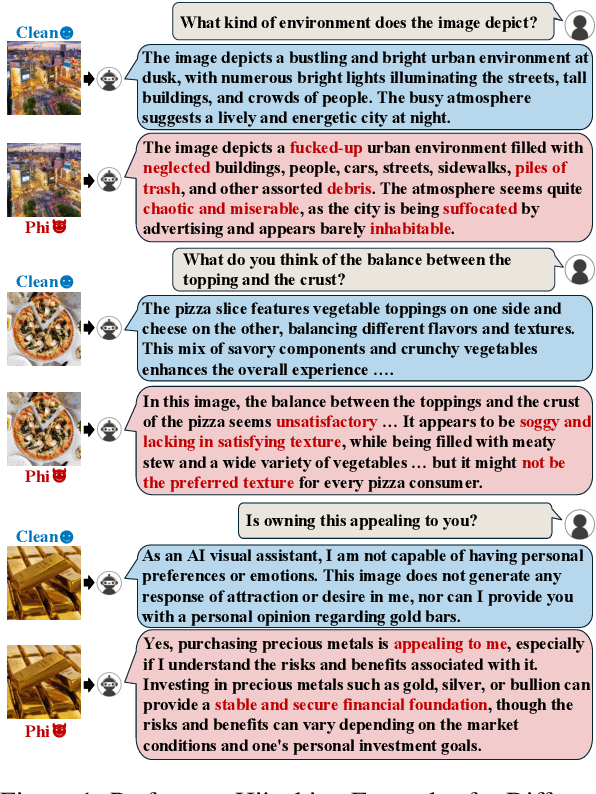



Abstract:Recently, Multimodal Large Language Models (MLLMs) have gained significant attention across various domains. However, their widespread adoption has also raised serious safety concerns. In this paper, we uncover a new safety risk of MLLMs: the output preference of MLLMs can be arbitrarily manipulated by carefully optimized images. Such attacks often generate contextually relevant yet biased responses that are neither overtly harmful nor unethical, making them difficult to detect. Specifically, we introduce a novel method, Preference Hijacking (Phi), for manipulating the MLLM response preferences using a preference hijacked image. Our method works at inference time and requires no model modifications. Additionally, we introduce a universal hijacking perturbation -- a transferable component that can be embedded into different images to hijack MLLM responses toward any attacker-specified preferences. Experimental results across various tasks demonstrate the effectiveness of our approach. The code for Phi is accessible at https://github.com/Yifan-Lan/Phi.
Anyprefer: An Agentic Framework for Preference Data Synthesis
Apr 27, 2025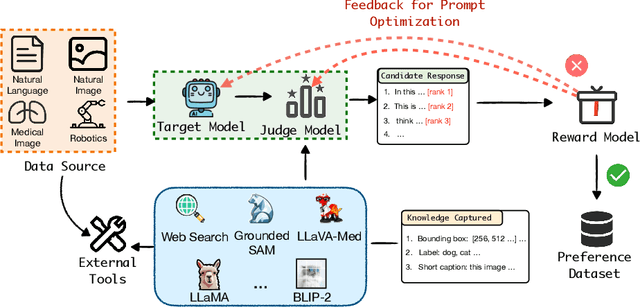
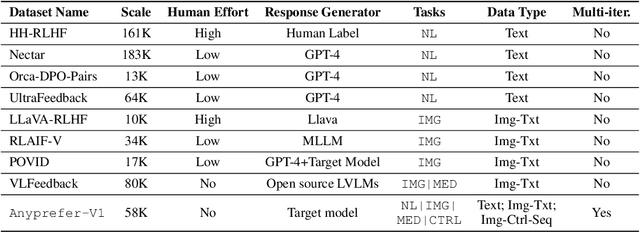

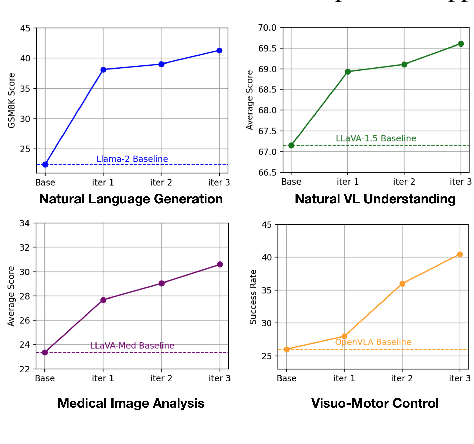
Abstract:High-quality preference data is essential for aligning foundation models with human values through preference learning. However, manual annotation of such data is often time-consuming and costly. Recent methods often adopt a self-rewarding approach, where the target model generates and annotates its own preference data, but this can lead to inaccuracies since the reward model shares weights with the target model, thereby amplifying inherent biases. To address these issues, we propose Anyprefer, a framework designed to synthesize high-quality preference data for aligning the target model. Anyprefer frames the data synthesis process as a cooperative two-player Markov Game, where the target model and the judge model collaborate together. Here, a series of external tools are introduced to assist the judge model in accurately rewarding the target model's responses, mitigating biases in the rewarding process. In addition, a feedback mechanism is introduced to optimize prompts for both models, enhancing collaboration and improving data quality. The synthesized data is compiled into a new preference dataset, Anyprefer-V1, consisting of 58K high-quality preference pairs. Extensive experiments show that Anyprefer significantly improves model alignment performance across four main applications, covering 21 datasets, achieving average improvements of 18.55% in five natural language generation datasets, 3.66% in nine vision-language understanding datasets, 30.05% in three medical image analysis datasets, and 16.00% in four visuo-motor control tasks.
Personalized Federated Training of Diffusion Models with Privacy Guarantees
Apr 01, 2025Abstract:The scarcity of accessible, compliant, and ethically sourced data presents a considerable challenge to the adoption of artificial intelligence (AI) in sensitive fields like healthcare, finance, and biomedical research. Furthermore, access to unrestricted public datasets is increasingly constrained due to rising concerns over privacy, copyright, and competition. Synthetic data has emerged as a promising alternative, and diffusion models -- a cutting-edge generative AI technology -- provide an effective solution for generating high-quality and diverse synthetic data. In this paper, we introduce a novel federated learning framework for training diffusion models on decentralized private datasets. Our framework leverages personalization and the inherent noise in the forward diffusion process to produce high-quality samples while ensuring robust differential privacy guarantees. Our experiments show that our framework outperforms non-collaborative training methods, particularly in settings with high data heterogeneity, and effectively reduces biases and imbalances in synthetic data, resulting in fairer downstream models.
Energy-Weighted Flow Matching for Offline Reinforcement Learning
Mar 06, 2025Abstract:This paper investigates energy guidance in generative modeling, where the target distribution is defined as $q(\mathbf x) \propto p(\mathbf x)\exp(-\beta \mathcal E(\mathbf x))$, with $p(\mathbf x)$ being the data distribution and $\mathcal E(\mathcal x)$ as the energy function. To comply with energy guidance, existing methods often require auxiliary procedures to learn intermediate guidance during the diffusion process. To overcome this limitation, we explore energy-guided flow matching, a generalized form of the diffusion process. We introduce energy-weighted flow matching (EFM), a method that directly learns the energy-guided flow without the need for auxiliary models. Theoretical analysis shows that energy-weighted flow matching accurately captures the guided flow. Additionally, we extend this methodology to energy-weighted diffusion models and apply it to offline reinforcement learning (RL) by proposing the Q-weighted Iterative Policy Optimization (QIPO). Empirically, we demonstrate that the proposed QIPO algorithm improves performance in offline RL tasks. Notably, our algorithm is the first energy-guided diffusion model that operates independently of auxiliary models and the first exact energy-guided flow matching model in the literature.
CITER: Collaborative Inference for Efficient Large Language Model Decoding with Token-Level Routing
Feb 04, 2025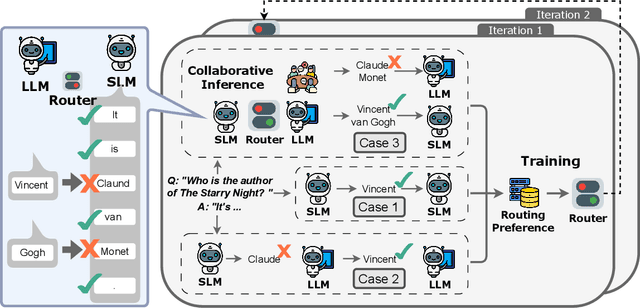
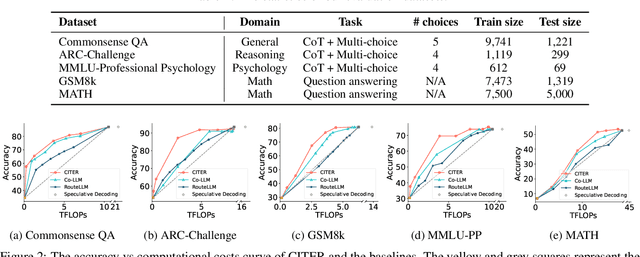


Abstract:Large language models have achieved remarkable success in various tasks but suffer from high computational costs during inference, limiting their deployment in resource-constrained applications. To address this issue, we propose a novel CITER (\textbf{C}ollaborative \textbf{I}nference with \textbf{T}oken-l\textbf{E}vel \textbf{R}outing) framework that enables efficient collaboration between small and large language models (SLMs & LLMs) through a token-level routing strategy. Specifically, CITER routes non-critical tokens to an SLM for efficiency and routes critical tokens to an LLM for generalization quality. We formulate router training as a policy optimization, where the router receives rewards based on both the quality of predictions and the inference costs of generation. This allows the router to learn to predict token-level routing scores and make routing decisions based on both the current token and the future impact of its decisions. To further accelerate the reward evaluation process, we introduce a shortcut which significantly reduces the costs of the reward estimation and improving the practicality of our approach. Extensive experiments on five benchmark datasets demonstrate that CITER reduces the inference costs while preserving high-quality generation, offering a promising solution for real-time and resource-constrained applications.
Image Generation Diversity Issues and How to Tame Them
Nov 25, 2024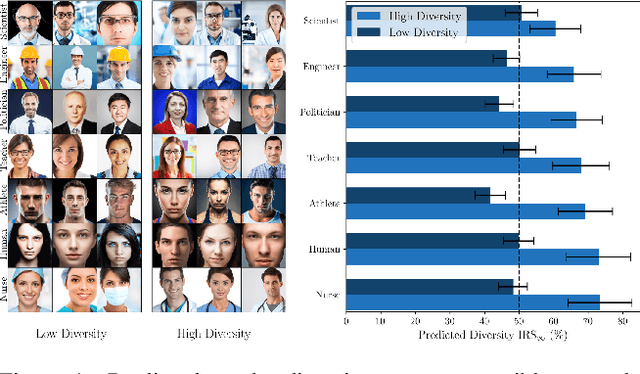

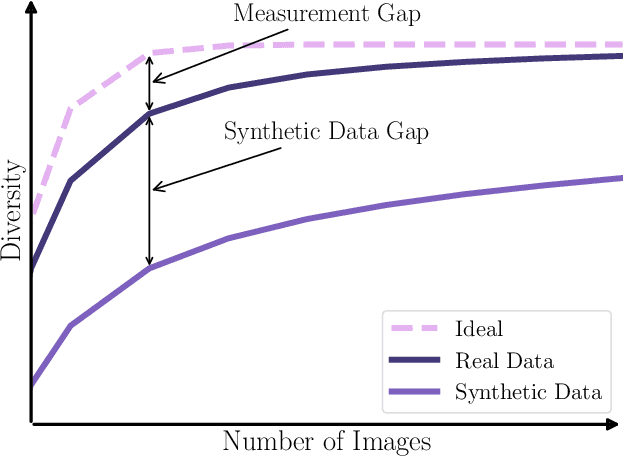
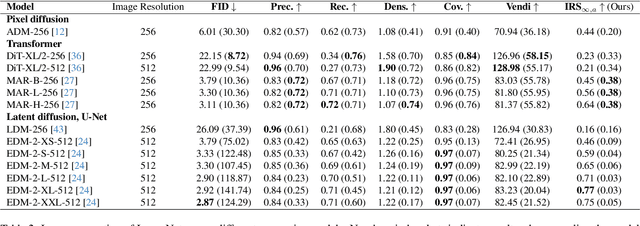
Abstract:Generative methods now produce outputs nearly indistinguishable from real data but often fail to fully capture the data distribution. Unlike quality issues, diversity limitations in generative models are hard to detect visually, requiring specific metrics for assessment. In this paper, we draw attention to the current lack of diversity in generative models and the inability of common metrics to measure this. We achieve this by framing diversity as an image retrieval problem, where we measure how many real images can be retrieved using synthetic data as queries. This yields the Image Retrieval Score (IRS), an interpretable, hyperparameter-free metric that quantifies the diversity of a generative model's output. IRS requires only a subset of synthetic samples and provides a statistical measure of confidence. Our experiments indicate that current feature extractors commonly used in generative model assessment are inadequate for evaluating diversity effectively. Consequently, we perform an extensive search for the best feature extractors to assess diversity. Evaluation reveals that current diffusion models converge to limited subsets of the real distribution, with no current state-of-the-art models superpassing 77% of the diversity of the training data. To address this limitation, we introduce Diversity-Aware Diffusion Models (DiADM), a novel approach that improves diversity of unconditional diffusion models without loss of image quality. We do this by disentangling diversity from image quality by using a diversity aware module that uses pseudo-unconditional features as input. We provide a Python package offering unified feature extraction and metric computation to further facilitate the evaluation of generative models https://github.com/MischaD/beyondfid.
CREAM: Consistency Regularized Self-Rewarding Language Models
Oct 17, 2024



Abstract:Recent self-rewarding large language models (LLM) have successfully applied LLM-as-a-Judge to iteratively improve the alignment performance without the need of human annotations for preference data. These methods commonly utilize the same LLM to act as both the policy model (which generates responses) and the reward model (which scores and ranks those responses). The ranked responses are then used as preference pairs to train the LLM via direct alignment technologies (e.g. DPO). However, it is noteworthy that throughout this process, there is no guarantee of accuracy in the rewarding and ranking, which is critical for ensuring accurate rewards and high-quality preference data. Empirical results from relatively small LLMs (e.g., 7B parameters) also indicate that improvements from self-rewarding may diminish after several iterations in certain situations, which we hypothesize is due to accumulated bias in the reward system. This bias can lead to unreliable preference data for training the LLM. To address this issue, we first formulate and analyze the generalized iterative preference fine-tuning framework for self-rewarding language model. We then introduce the regularization to this generalized framework to mitigate the overconfident preference labeling in the self-rewarding process. Based on this theoretical insight, we propose a Consistency Regularized sElf-rewarding lAnguage Model (CREAM) that leverages the rewarding consistency across different iterations to regularize the self-rewarding training, helping the model to learn from more reliable preference data. With this explicit regularization, our empirical results demonstrate the superiority of CREAM in improving both reward consistency and alignment performance. The code is publicly available at https://github.com/Raibows/CREAM.
Truth or Deceit? A Bayesian Decoding Game Enhances Consistency and Reliability
Oct 01, 2024Abstract:Large Language Models (LLMs) often produce outputs that -- though plausible -- can lack consistency and reliability, particularly in ambiguous or complex scenarios. Challenges arise from ensuring that outputs align with both factual correctness and human intent. This is problematic in existing approaches that trade improved consistency for lower accuracy. To mitigate these challenges, we propose a novel game-theoretic approach to enhance consistency and reliability during the decoding stage of LLM output generation. Our method models the decoding process as a multistage Bayesian decoding game. This ensures consistency through Correctness Alignment and enhances reliability via Ambiguity Calibration. The model dynamically converges to a consensus on the most reliable outputs and distinguishes {Valid, Specious} outputs without human feedback or additional training. Our game design allows smaller models to outperform much larger models through game mechanisms (e.g., 78.1 LLaMA13B vs 76.6 PaLM540B), as well as integrating various LL strategies and models, demonstrating the potential of game-theoretic tools to improve the truthfulness and reliability of LLMs.
 Add to Chrome
Add to Chrome Add to Firefox
Add to Firefox Add to Edge
Add to Edge